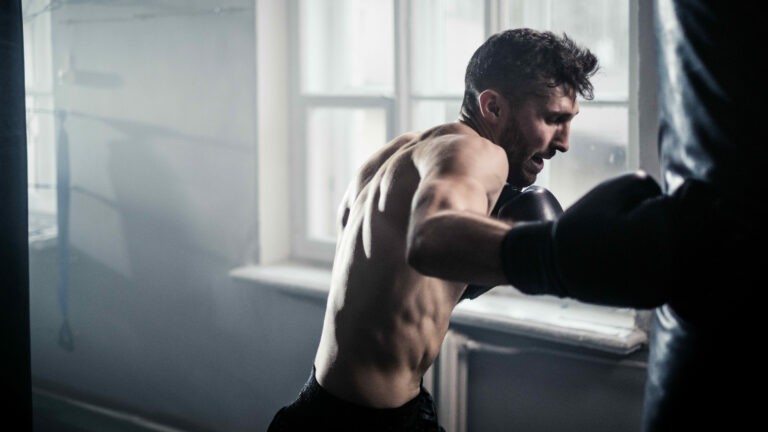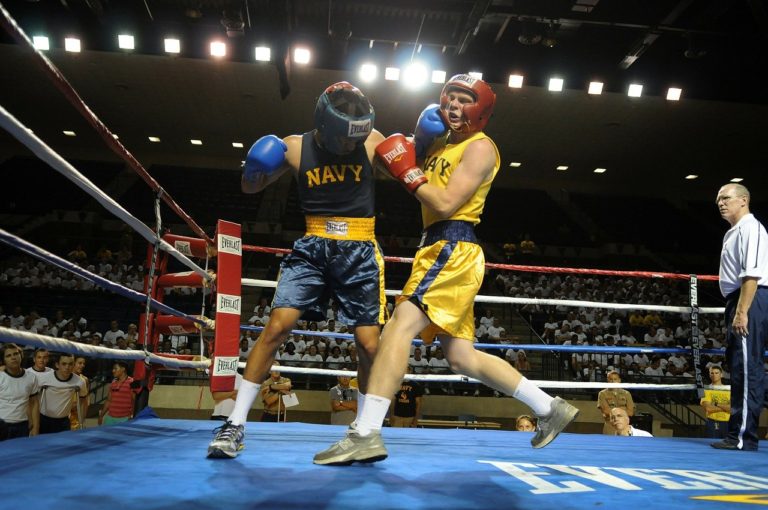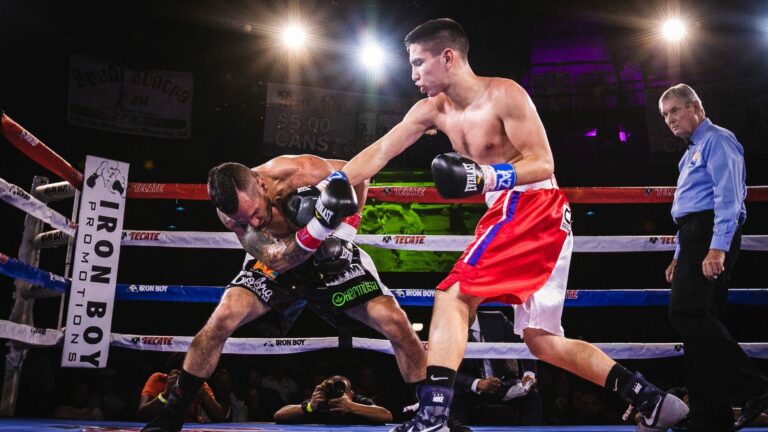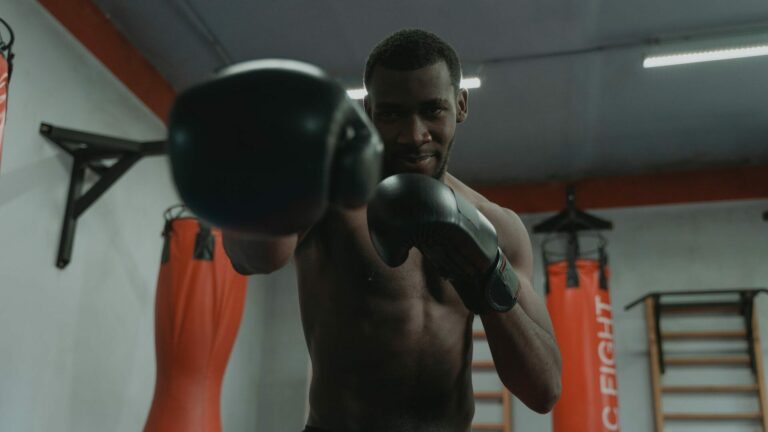How to Increase Boxing Power – A Complete Guide

Generally speaking, power is something you are born with, there are some things you can do to improve that power – which we will cover in this article – but everyone is limited by their genetic potential.
Essentially it comes down to the connective structure of your muscles to your bones and the type of muscle fibers you have, Firas Zahabi on JRE does an excellent job of explaining this if you’re interested in the science behind power. This is why some fighters like Deontay Wilder, George Foreman, and Mike Tyson had freakish power in their punches.
A powerful punch is always a useful tool in boxing, especially if you find yourself getting outboxed. However, it isn’t the only thing that goes into producing a knockout. Precision, accuracy, and timing are the fundamental elements of producing a knockout, power comes after. But regardless, while power for the most part comes from genetics, there are certain things you can do to improve it.
Weight
The reason we have weight classes in boxing is that weight has the most direct correlation with power. Generally speaking, the heavier you are (to an extent) the more power you’ll have behind your punches. However, this could result in slower movements and reduced cardiovascular endurance. Your power would only start to decrease if you put on so much weight that you started to lose mobility and essentially became unhealthy.
However, this doesn’t mean that you should balloon up in weight if you want to increase power. If you want to gain a weight advantage over your opponent, maximizing lean muscle mass would be the route to take.
This is because muscle holds water and fat doesn’t which would mean that you would be able to lose more water weight for weigh-ins and could therefore replenish more weight in the 24 hours after the weigh-in so that when it comes to fighting, you have a significant advantage over your opponent. There is a lot of speculation regarding the safety of cutting weight and many claim its detrimental to a fighter’s health so its hardly recommended but it is common practice among fighters, specifically mixed martial artists.
That being said, I don’t think most people reading this article are professional fighters and for regular people like you and me, weight cutting doesn’t make any sense. So a much better and healthier alternative would be to slowly increase in weight if you feel you have the capacity or need to by training, lifting weights, and eating in a calorie surplus. However, this needs to be done with advice from a nutritionist as everybody is different, and making this kind of lifestyle change may not be healthy for everyone.
This is a simple graph that shows the power for different weight classes. Of course, power will vary from fighter to fighter because of technique, genetics, momentum, and more but here we’re looking at power as an average. But as a disclaimer, punching power in any weight class can far surpass the figures shown below.
| Weight-class | Weight | Force N |
| Minimumweight | 105 pounds (48 kg) | 536.448N |
| Light Flyweight | 108 pounds (49 kg) | 547.624N |
| Flyweight | 112 pounds (51 kg) | 569.976N |
| Super Flyweight | 115 pounds (52 kg) | 581.152N |
| Bantamweight | 118 pounds (53.5 kg) | 597.916N |
| Super Bantamweight | 122 pounds (55 kg) | 614.68N |
| Featherweight | 126 pounds (57 kg) | 637.032N |
| Super Featherweight | 130 pounds (59 kg) | 659.384N |
| Lightweight | 135 pounds (61 kg) | 681.736N |
| Super Lightweight | 140 pounds (63.5 kg) | 709.676N |
| Welterweight | 147 pounds (67 kg) | 748.792N |
| Super Welterweight | 154 pounds (70 kg) | 782.32N |
| Middleweight | 160 pounds (72.5 kg) | 810.26N |
| Super Middleweight | 168 pounds (76 kg) | 849.376N |
| Light Heavyweight | 175 pounds (79 kg) | 882.904N |
| Cruiserweight | 200 pounds (91 kg) | 1,017.016N |
| Heavyweight, unlimited | 225 pounds (102kg) | 1,140.6N |
It’s easy to critique this data because punches can’t be measured in linear terms because of how many variables go into punching power, and secondly lighter fighters tend to have higher punch speeds which is why this isn’t an accurate representation of power in each weight division. However, it does show the effect that mass will have on power, providing all the other variables stay the same.
Form & Leverage
The second most important factor for power ties in with the first because the correct form will allow you to transfer your weight in an efficient manner so that it translates into a more powerful punch.
A great example of what re-visiting fundamentals can do is Tyson Fury in his second and third fight with Deontay Wilder. Fury was always known as a boxing genius, a big man who uses evasive movement and reflexes to outclass his opponents, making them look clumsy but he didn’t have a reputation as a knockout artist. However, in the rematch and trilogy with Wilder, he was aiming for a knockout, so he went to Sugar Hill Steward with the Kronk gym and set up a game-plan to use his natural size advantage to its maximum potential so he could inflict as much damage as possible. As a result of this change of style, he looked more planted when throwing big power punches and Fury was able to secure knockout victories in both the second and third fights.
Although you punch with your arms, the power of a punch really starts at the ground, travels through the legs, the core, chest, shoulders, and is then forced out by the arm. Think of it like a whip: power comes from leverage.
Jab: To maximize power from the jab, you want to push forward with it, putting your opponent on the back foot in the process. However, while you can use the jab as a power punch it doesn’t mean you should. First of all, it is the weakest punch in a boxer’s arsenal, and secondly, its such a diverse tool which means that you don’t necessarily need it to inflict damage. You can use it to find your range, create openings, and establish control.
Cross: The cross is usually the most powerful punch in boxing, you punch with your dominant hand and use your body weight to create power. As the punch is turned over, the back foot pivots, and the hips twist into punch putting most of the fighter’s weight on the front leg, allowing the fighter to transfer their weight into the strike.
Hook: A hook is a punch that comes around in a circular fashion and is most commonly used by boxers in close quarters or at awkward angles. By throwing the punch in a curve, less space is required to generate power and it also allows boxers to attack the sides of their opponent. With a hook, either the left or right foot pivots (depending on the punch – left foot for left hook and right foot for right hook) inwards with the knee. The pivoting foot lifts slightly as power is transferred through the twist of the hips into the arced shoulder and arm.
Uppercut: An uppercut is an incredibly effective punch in boxing because in many cases, you can’t see them coming. When you can anticipate a punch, your body’s involuntary response is to prepare for the strike by tensing up which means that the punch is less likely to be as detrimental. In the absence of this, a blow when the body is loose is much more likely to produce a knockout. An uppercut is all about vertical movement, whether throwing it with your lead or rear hand, the uppercut benefits greatly from rotational upwards movement from the feet, this means pivoting on the correlating foot at an upwards gradient. Changing levels will also help put power into uppercuts as they build momentum, Mike Tyson became notorious for his springing uppercuts from low down and the proof is in his knockout reel.
Medicine Ball Throws
Medicine ball throws are about conditioning the muscle fibers to twitch explosively in a punching movement. This exercise involves throwing a medicine ball into a wall hard repetitively, using one hand to push and the other to balance. Stand with your side towards the wall and having a partner help catch and throw them back to you makes the exercise more efficient and intense. This movement isolates a lot of the muscle groups that are used during a punch, in particular hooks which are why its good to perform this exercise with both hands.

Explosive push-ups
Its no surprise that push-ups are one of the most popular exercises for boxing, they only require your body weight and work the muscles in the upper body that are used when throwing a punch. In order for push-ups to be effective, the correct form is mandatory.
Your legs, core, and shoulders should all be perfectly inline and dead straight, like a plank. The hands should be placed apart at around the same width as your shoulders and the elbows should be tucked to your sides as you go down, only 30 degrees away from your body.
Once you’re confident with the fundamentals of a push-up, you can then start experimenting with things like explosive push-ups, where you push yourself into the air for each repetition so that your hands leave the floor momentarily. These movements are greatly beneficial for improving fast muscle twitch movements, like punching hard but they are also a great exercise (in large volume) for improving conditioning and endurance.
Muscle ups
Muscle-ups are great for increasing explosive power, they are difficult and require a massive amount of force and momentum to perform correctly. The arms, back, shoulders, and chest are all involved in muscle-ups which makes it a really well-rounded exercise and they are also the upper body parts that are involved in a punch.
To start training muscle-ups, you want to perfect pull-ups first. If you’re able to perform 10 consecutive pull-ups, then you’re probably strong enough to perform muscle-ups. The actual movement is tricky to master and it involves rotating the wrists as you get to the top of the bar which is why resistance bands are a good way to introduce yourself to muscle-ups. They essentially, take some of your weight so that you can perfect the technique first.
Landmine punches
Weight training can also be beneficial for increasing power, an exercise that has gained popularity for focusing directly on punching power is the land mine punch. To perform a landmine punch you have to have a large bar with a weight at one end, the side with the weight is held in one hand is thrust upwards like a punch. However, the trajectory and upper-body form and completely off for this exercise but it does strengthen the fundamental muscles and movements behind a punch.
Conclusion
Power is such a difficult topic to explain to new boxers because as we mentioned earlier, power is fundamentally genetic. For context its like comparing Usain Bolt and Mo Farah, they are both incredible runners but Bolt is very quick for a short distance whereas Farah is able to keep running at a consistent pace for a longer time. Everyone will have aspects where they are gifted and where they are not.
However, it doesn’t always take massive shots to put someone away, boxing is all about precision, timing, and accuracy. Power will help, but only to a degree, so it’s not always worth putting all your time into getting a bigger punch.






